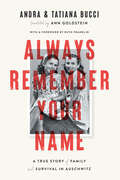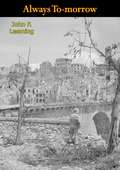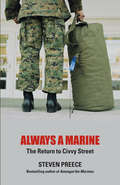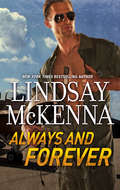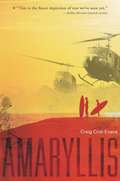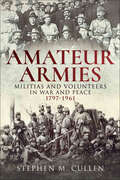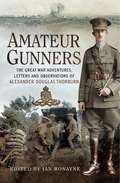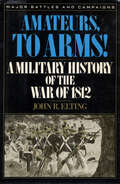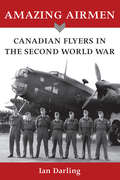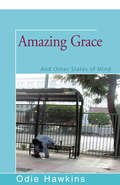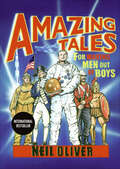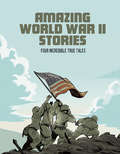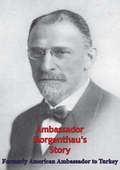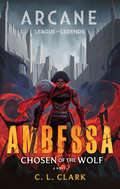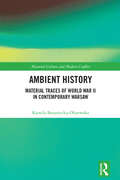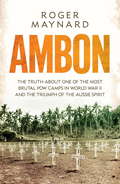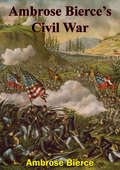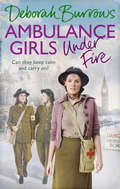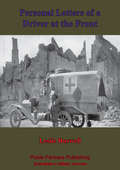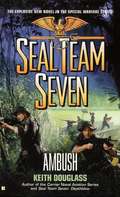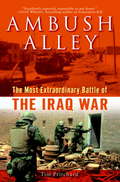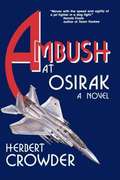- Table View
- List View
Always Remember Your Name: A True Story of Family and Survival in Auschwitz
by Andra Bucci Tatiana BucciA haunting WWII memoir of two sisters who survived Auschwitz that picks up where Anne Frank's Diary left off and gives voice to the children we lost.On March 28, 1944, six-year-old Tati and her four-year-old sister Andra were roused from their sleep and arrested. Along with their mother, Mira, their aunt, and cousin Sergio, they were deported to Auschwitz. Over 230,000 children were deported to the camp, where Josef Mengele, the Angel of Death, performed deadly experiments on them. Only a few dozen children survived, Tati and Andra among them. Tati, Andra, and Sergio were separated from their mothers upon arrival. But Mira was determined to keep track of her girls. After being tattooed with their inmate numbers, she made them memorize her number and told them to &“always remember your name.&” In keeping this promise to their mother, the sisters were able to be reunited with their parents when WWII ended. An unforgettable narrative of the power of sisterhood in the most extreme circumstances, and of how a mother&’s love can overcome the most impossible odds, the Bucci sisters' memoir is a timely reminder that separating families is an inexcusable evil.
Always There: A gripping saga where the past and the present threaten to collide
by Pamela EvansTwo sisters discover that meddling in the past can bring about both happiness and long forgotten, devastating secrets... Pam Evans, much-loved author of In the Dark Streets Shining, brings us another tale of love, family and hope, clouded by two sisters' heart-breaking past. Perfect for fans of Dilly Court and Lindsey Hutchinson. 'The leading characters are finely drawn... crisp prose... a superb and heartwarming read' - Irish IndependentIn 1930s London, two little girls are lonely and bewildered after the tragic death of their mother. Daisy and June are now destitute and must go to the local orphanage. Once there, they take comfort in each other but they are robbed of even this consolation when they are parted because June is taken away for adoption. Years later, although out of touch and worlds apart, both share a disturbing childhood memory which will connect them forever. A memory that takes on a ghastly significance when June discovers the reason they were abandoned...What readers are saying about Always There: 'Simple read, simple tale, simply engrossed! It is the sort of book that warrants a sequel' 'I thoroughly enjoyed another great story from Mrs E, I couldn't put the kindle down'
Always There: A gripping saga where the past and the present threaten to collide
by Pamela EvansTwo sisters discover that meddling in the past can bring about both happiness and long forgotten, devastating secrets... Pam Evans, much-loved author of In the Dark Streets Shining, brings us another tale of love, family and hope, clouded by two sisters' heart-breaking past. Perfect for fans of Dilly Court and Lindsey Hutchinson. 'The leading characters are finely drawn... crisp prose... a superb and heartwarming read' - Irish IndependentIn 1930s London, two little girls are lonely and bewildered after the tragic death of their mother. Daisy and June are now destitute and must go to the local orphanage. Once there, they take comfort in each other but they are robbed of even this consolation when they are parted because June is taken away for adoption. Years later, although out of touch and worlds apart, both share a disturbing childhood memory which will connect them forever. A memory that takes on a ghastly significance when June discovers the reason they were abandoned... What readers are saying about Always There: 'Simple read, simple tale, simply engrossed! It is the sort of book that warrants a sequel' 'I thoroughly enjoyed another great story from Mrs E, I couldn't put the kindle down'
Always To-morrow
by John F. LeemingIn November 1940, an R.A.F. aeroplane crashed near Catania, Sicily. On board were Air Marshal O. T. Boyd on his way to Cairo as Air Officer Commanding Middle East, and John Leeming, a member of his staff, who before the war was a well-known private pilot and the author of several amusing books. Air Marshal Boyd and Mr. Leeming were taken prisoner by the Italians and, six months later, they were joined by a bevy of generals and other senior British officers, including Major-General Neame, V.C., Lieutenant-General O’Connor, Major-General Carton de Wiart, V.C., and Major-General Gambier-Perry.Always To-morrow, which was first published in 1951, is an account of the life as prisoners of war in Italy of this group of high ranking officers, beginning with the aircraft crash in Sicily which wrecked the career of Air Marshal Boyd.Widely regarded as one of the most amusing books written about World War II, the hopes and disappointments of the several attempts at escape are told in a most entertaining way, and the lack of emphasis on the less amusing aspects of life as a prisoner of war only serves to underline the unfailing courage, enterprise and patience of these senior officers.“The funniest war story of all, Leeming’s adventures as a prisoner of the Italians are told with a rare humour and a keen eye for the absurd. There is drama, too, in his story, but Mr. Leeming is irrepressible.”—Sunday Graphic
Always a Marine: The Return to Civvy Street
by Steven PreeceIn Amongst the Marines, Steven Preece vividly depicted his excessive, violent lifestyle as an elite Royal Marine Commando. Now Always a Marine covers the author's struggle to leave that lifestyle behind following his departure from the service. Back on civvy street for the first time in over seven years, Preece finds it extremely difficult to adapt and struggles to shake off the belligerent mentality he developed while in the Marines. Despite these difficulties, he marries and starts a family, but this positive change is not enough to turn his life around. Preece soon discovers that his tendency towards violence will not be tolerated in the civilian workplace and, after finding himself blacklisted by many companies in his area, he is forced to look for employment abroad. This quest for work takes Preece to France, where he is caught up in a hotel fire; Germany, where he is double-crossed out of his job and later teams up with an ex-SAS trooper; Morocco, where an incident lands him in jail and he is later shot at by border police; and Thailand, where he fights in a boxing ring with a former French Legionnaire and gets caught up in a business scam.Having settled back in the UK, Preece's behaviour remains excessive. He severely injures his head and suffers minor brain damage after a heavy-drinking session. Upon recovering, he looks for something else to believe in and begins training in ninjutsu, the martial art of the ninjas, who view aggression as a sign of weakness. This, combined with the love of his family, finally enables him to put his past behind him. Always a Marine is the action-packed, often shocking account of one ex-Marine's 13-year struggle to control the aggression he learnt as a serviceman in order to become a respectable civilian.
Always and Forever
by Lindsay MckennaRediscover this moving fan-favorite tale of finding a second chance at happiness from New York Times bestselling author Lindsay McKenna Captain Kyle Anderson can't believe his buddy Mike is tying the knot. And when Mike, a fellow captain in the US Air Force, asks Kyle to be his best man, of course Kyle says yes. When he flies home from Thailand, where his squadron is based, Kyle finally gets to meet the woman his friend has been talking about for a year. But what he never expected is for Gale Remington to be so...alluring. And he certainly isn't prepared for the sparks that fly between them. Gale is beyond happy to be marrying Mike. So why, when she meets his best man, Kyle, does her heart beat a little quicker, her breath come a little faster? He's her fiancé's best friend--nothing can happen between them. But nothing is certain in the theater of war, and fate may have other plans for her and Kyle.
Amaryllis
by Craig Crist-Evans"This is a powerful tale of family, forgiveness, and acceptance of what life throws in our paths- but ultimately, with its almost painful realism, this is the finest depiction of war we've yet seen for young readers." -- KIRKUS REVIEWS (starred review) AMARYLLIS. It was the name of the ship that ran aground on Singer Island, Florida, during a hurricane in 1965. It became a battle cry for Jimmy Staples and his older brother, Frank, and a code word for going surfing together. But now that eighteen-year-old Frank is off battling the enemy (and his own addictive demons) in Vietnam and fifteen-year-old Jimmy is left to deal with the repercussions at home, "Amaryllis" takes on an ominous new meaning - a symbol of what happens when life places the unexpected in our paths. Craig Crist-Evans has written a wrenching novel of a family whose internal battles chase one son away - into the clutches of a war and an enemy he could never have imagined. Told both from a soldier's view and by the brother he leaves behind, Amaryllis is an ideal choice for students learning about the Vietnam era, or for any reader curious about the reality of war.
Amateur Armies: Militias and Volunteers in War and Peace, 1797–1961
by Stephen M. CullenA history of volunteer armies spanning from the French Revolutionary Wars and the War of 1812 to pre-1914 Ireland and the Bay of Pigs.Amateur Armies examines the military and social history of volunteer armies around the western world from the failed French invasion of South Wales in 1797 to the disastrous anti-Communist invasion of the Bay of Pigs in Cuba in 1961.It brings together some fascinating military actions across more than a century and a half of history and explores the social and political context in the countries involved. Stephen Cullen’s absorbing and original book is the first general survey of the role of amateur armies during the period.Included are chapters on a series of wars in which militias played critical parts. In each case, their actions and effectiveness are described as is the background from which they came, and the social and political circumstances in which they operated. This pioneering study offers a valuable insight into each of the amateur armies covered and opens up an important and hitherto neglected aspect of military history.
Amateur Gunners: The Great War Adventures, Letters and Observations of Alexander Douglas Thorburn
by Ian RonayneAfter training at St John's Wood in London and in Exeter, Alexander Douglas Thorburn was posted to the BEF in France, joining the 2/22nd London (Howitzer) Battery, Royal Field Artillery as a subaltern officer. After service in the Vimy Ridge sector, with his division, the 60th (2/2nd London) Division, he crossed the Mediterranean to join the British Army in Salonika. Following a further move in mid-1917, Thorburn arrived in Palestine where he saw service with the 74th (Yeomanry) Division during the advance on Jerusalem. A final move in 1918 took the now Captain Thorburn back to the Western Front to take part in the Advance to Victory during the closing months of the war. After the war, Thorburn wrote an account of his military service between 1916 and 1918, recording his experiences in France, Greece and Palestine as well as his initial training in England. He also wrote a series of observations on life as a gunner during the First World War. Both the account and observations were published as a book, Amateur Gunners, in 1933 by William Potter of Liverpool. Today, the book is out of print. In addition to the book, of which a small number of copies still exist of course, there are an extensive series of private letters written by Thorburn while on active service to his mother, father and other relatives. The letters are in the possession of Thorburn's only grandson. Together, the book and letters offer a fascinating insight into the life of a First World War artillery officer. Lucidly written in a candid style, Thorburn shows excellent observation, description and narration skills. While Amateur Gunners itself is worthy of reprint, when combined with Thorburn's private letters and historical context from author Ian Ronayne, this book offers a unique look at a gunner's experience during the Great War.
Amateurs, to Arms!: A Military History of the War of 1812 (Major Battles and Campaigns)
by John R. EltingBegun in ignorance of the military reality, the War of 1812 was our "most unmilitary war," fought catch-as-catch-can with raw troops, incompetent officers, and appallingly inadequate logistics. American soil was invaded along three frontiers, thte nation's capital was occupied and burned, and the secession of the New England states loomed as a possibility. In Amateurs, to Arms! distinguished military historian Colonel John R. Elting shows how the young republic fought and almost lost its "Second War for Independence," and how it was saved by the handful of amateur soldiers and sailors who survived, masters their deadly new professions, and somehow battled Great Britain to a standstill along our wilderness borders and on the high seas.
Amateurtheaterprojekte zu Holocaust und Nationalsozialismus: Eine qualitative Studie zur Erinnerungskultur im 21. Jahrhundert (Holocaust Education – Historisches Lernen – Menschenrechtsbildung)
by Lisa SchwendemannIn diesem Buch wird das Rezeptionsverhalten von Zuschauer(inne)n erforscht, welche Amateurtheaterprojekte zu ‚Holocaust und Nationalsozialismus‘ besuchen. Die Studie ist qualitativ angelegt, indem Interviews mit Hilfe der Grounded Theory ausgewertet werden. Es wird der Frage nachgegangen, welcher Personenkreis von Amateurtheaterprojekten angesprochen wird, wie diese Projekte von den Theaterbesucher(inne)n wahrgenommen werden und welche Wirkungen die Rezipient(inn)en während und nach dem Theaterbesuch an sich feststellen. Es kann herausgearbeitet werden, dass die in dieser Arbeit untersuchten Projekte eine intellektuelle Auseinandersetzung mit ‚schwieriger‘ Geschichte fokussieren. Die in den Amateurtheaterprojekten gewählte theatrale Darstellungsweise spricht tendenziell ein ‚bildungsnahes‘ Publikum an, das bereits über Vorwissen zur Thematik verfügt und bereit ist, sich während und nach dem Theaterbesuch aktiv mit ‚Holocaust und Nationalsozialismus‘ auseinanderzusetzen. Hierzu hat die Autorin ein Rezeptionsmodell herausgearbeitet, das die intellektuelle Auseinandersetzung mit ‚schwieriger‘ Geschichte umfasst.
Amazing Airmen: Canadian Flyers in the Second World War
by Ian DarlingCanadian and British airmen engaged in fierce and deadly battles in the skies over Europe during the Second World War. Those who survived often had to overcome incredible obstacles to do so — dodging bullets and German troops, escaping from burning planes and enduring forced marches if they became prisoners. In one story, a tail gunner from Montreal survived despite being unconscious when blown out of his bomber. Another story describes how the crew of a navigator from Ottawa used chewing gum to fill holes in their aircraft. And another tells how a pilot from northern Ontario parachuted out of his plane and became the target of a German machine-gunner, but within hours 120 Germans surrendered to him. These painstakingly researched stories will enable you to feel what now-aging veterans endured when they were young men in the air war against Nazi Germany.
Amazing Grace: And Other States of Mind
by Odie HawkinsAn enchanting intro to a collection of unforgettable characters--Elizabeth, "Queen of the Projects"; the girl "Billie" who sings like Lady Day; young Randolph who, to his family's embarrassment, grows a second head for a while; Dean Dale Jackson, talented writer, sculptor, auto mechanic, and dedicated to the underbelly of a bottle; the Vernon family upwardly mobile but required by a will to grow cotton in their suburban backyard; and Marlene and James, who find happiness in an unexpected way, in marriage.
Amazing Tales for Making Men Out of Boys
by Neil OliverStories of heroism, exploration, and sacrifice -- including Apollo XIII and Scott of the Antarctic -- that inspire boys to be courageous, selfless, and open to adventureTales of brave and selfless deeds used to be part of every boy&’s education. We grew up sharing stories with our fathers, uncles, and grandfathers of how other men had lived their lives, met their challenges, reached their goals, and faced their deaths. Becoming a man was about comradeship and standing by your friends whatever the circumstances. And it meant that sometimes it was more important to die a hero than live a coward&’s life. Through Neil Oliver&’s vivid, stirring accounts we can rediscover the stories that inspire men to perform acts greater than themselves. These are the epics that we should all know by heart; the tales of courage, endurance, and sacrifice that made men out of boys.Amazing Tales for Making Men Out of Boys is packed with classic stories of courage and heroism from around the world and includes four stories especially for the American edition: Omaha Beach, June 6th 1944; The Alamo; The Civil War Battle of Shilo; and The Revolutionary War Sea Battle of John Paul Jones and the Bon Homme Richard.
Amazing World War II Stories: Four Incredible True Tales (Amazing World War II Stories)
by Nel Yomtov Blake Hoena Bruce BerglundIn times of war, soldiers on the front lines must show their bravery. But acts of courage by some people aren't known until years after the fighting ends. From flying bombing missions in the dead of night, to tricking the enemy with fake encampments and unbreakable codes, to surviving horrific treatment by the enemy through sheer force of will, these incredible true tales will show how courage in war is often displayed by history's unsung heroes.
Ambassador Morgenthau’s Story [Illustrated Edition]
by Henry MorgenthauIllustrated with 54 photographs and portraits.The memoirs of the American Ambassador to Turkey during the First World War, covering the political dealing at the top of the Ottoman Empire and the events of the Armenian disaster.The Memoirs of Henry Morgenthau Sr. cover the period that he was in office as United States Ambassador to the Ottoman Empire; his memoirs reflect on the two moments events that characterized the period. The first event was of course World War that raged on throughout his tenure and he records how he sought to ensure the safety of the American citizens in the Empire as well as serving as much as possible the interests of the Allied nations whose embassies had been withdrawn. His anecdotes of the German and Turkish generals and ministers who inhabited the highest echelons are well worth reading and a rarity in English.The Second event was the Armenian massacres which are now overshadowed by the Holocaust of the Jews during the Second World War, however the suffering of the Armenian minority that were targeted by the Ottoman Empire's policy was just as great a crime against humanity; indeed the very word 'Genocide' was coined to describe this terrible period. Few books in English describe the awful suffering of this period of the First World War, however the author wrote voluminously of the incidents and even toured the affected areas. His memoirs are perhaps the best first-hand details of this terrible event by a neutral outsider, on an issue that remains contentious to this day.
Ambessa: A League of Legends: Arcane Novel
by C. L. ClarkSet in the blockbuster and award-winning universe of League of Legends: Arcane and written by award-winning author C. L. Clark, discover a thrilling epic fantasy novel where Ambessa Medarda truly learns what it means to be a Chosen of the Wolf. Medarda over all. Ambessa Medarda: Warrior, general, mother. She is a woman to be feared, and the Medardas are unrivaled in their pursuit of glory. She has led conquests and armies. She has slain legendary beasts. She has made grave sacrifices in her ascent up the ranks. And for this she was rewarded: She entered the realm of death and was granted a vision of herself upon the throne of the vast Noxian empire. But before she can lead her empire, she must become head of her own clan. Yet the title is contested by her cousin and former confidante, Ta&’Fik. He knows the bloody sins of Ambessa&’s past. And he knows he cannot allow her to rise. They will fight a war for the very soul of the Medardas. But the war won&’t be fought on battlefields alone. Ambessa&’s daughter, Mel, can deftly break through the walls around anyone&’s heart, and she&’ll put her talents to use for her mother. Yet despite Mel&’s strength, Ambessa sees only a child who lacks her killer instincts. Mel knows she can be the leader Ambessa wants her to be, if only she gives her time. With her family betraying her, enemies closing in on all sides, and unseen forces moving in the shadows, every day proves more dangerous than the last. But Ambessa will not bow. She will burn the world down to claim her place in it.
Ambient History: Material Traces of World War II in Contemporary Warsaw (Material Culture and Modern Conflict)
by Kamila Baraniecka-OlszewskaAmbient History presents the role urban fabric plays in constructing the wartime history of Warsaw. It focuses on history embedded in matter and details the practices followed by municipal institutions, artists and historical reenactors who pull history out of the background through their actions.The book offers a new perspective on the material history of the city. It presents the concept of ambient history – history hidden in the background, in the landscape – waiting to be utilised by individuals coming into contact with the fabric of the city. It draws on anthropological considerations of history which embrace non-academic methods of conceptualising the past and processes of democratising history. The book has two principal objectives. One is to give theoretical grounding to the term ‘ambient history’, which facilitates the conceptualisation of material history and the role experiencing it plays in the process of constructing history. The other is to try and determine the limits of the heuristic potential of posthumanist reflection on materiality in reference to research focused on the making of history.Therefore, the book is valuable reading for researchers studying non-academic methods of curating history: scholars investigating materiality and things, anthropologists of history, scholars of heritage studies, experts in urban studies, historians focused on public history and archaeologists analysing the discipline’s theory.
Ambon: The truth about one of the most brutal POW camps in World War II and the triumph of the Aussie spirit
by Roger MaynardSurvival, heroism, courage and mateship in Ambon - a place of nightmares.In February, 1942, Ambon, an Indonesian island north of Darwin, fell to the Japanese army and the Allied forces defending it were captured. Over a thousand of these soldiers were Australian. By the end of the war, just one-third of them had survived and Ambon became a place of nightmares, one of the most notorious of all POW camps the war had seen.Many of the men captured were massacred, and of those who initially survived, many later succumbed to the sadistic brutality of the Japanese guards. Starvation also took a fearful toll, and then there were the medical 'experiments'. It was a place almost without hope for those who held on, made worse by the fact that the savagery inflicted on them wasn't limited to their captors but also came from their own. One soldier described their hopelessness towards the end with the bleak words: 'The men knew they were dying.'Yet astoundingly there were survivors and in Ambon they speak of not just the horrors, but the bravery, endurance and mateship that got them through an ordeal almost impossible to imagine.The story of Ambon is one of both the depravity and the triumph of the human spirit; it is also one that's not been widely told. Until now.
Ambrose Bierce’s Civil War
by Ambrose Bierce William MccannThis powerful collection contains the very best of this world-renowned author's writings. All of the short stories and factual accounts of the Civil War presented here form a searing, unflinching portrait of this terrible war. For fiction and non-fiction fans and history buffs alike.
Ambulance Girls Under Fire
by Deborah BurrowsIn times of war, how do you know who to trust?Celia Ashwin has driven ambulances throughout the Blitz for the Bloomsbury Auxiliary Ambulance Depot. Cool under fire, she revels in her exciting and extremely dangerous job. When her husband, a known Nazi supporter, is released from prison, Celia refuses to return to her unhappy marriage. Instead she joins forces with Simon Levy, a man who appears to despise her, to help a young Jewish orphan. In so doing she discovers that one ruthless traitor can be more dangerous than any German bomber, and that love can cross any boundary.A heartwarming saga about a woman doing her bit for the war effort. Full of wartime adventure, romance and heartbreak, this is perfect for fans of Daisy Styles, Donna Douglas and Nancy Revell
Ambulance No. 10. Personal Letters Of A Driver At The Front [Illustrated Edition]
by Leslie Buswell"Letters describing the daily life and activities of a section of the voluntary "American Ambulance Field Service in France", operating over a period of four months in 1915 in Lorraine in support of the French.These letters were written by a member of the American Ambulance Field Service in France, a voluntary organisation that came into existence soon after the outbreak of war and in 1916 had over 200 motor ambulances. They were driven by young American volunteers, most of them graduates of American universities, who got no salary but their living expenses were paid. The ambulances were grouped in sections of twenty to thirty vehicles, attached to the French Armies and carried the wounded between the front and Army Hospitals within the Army zone. They were particularly useful in Alsace where their light but powerful vehicles were able to cope with the steep mountain passes which French motor ambulances could not manage. The section in which the writer of these letters served and whose daily life and activities he describes was located in Lorraine. The letters cover a period of four months from June to October 1915 and were first published in 1915 under the title With the American Ambulance Field Service in France, changed to Ambulance No 10 for this 1916 edition, purely for the sake of brevity. There is plenty of action to read about in this correspondence and there are interesting photographs."-N&M Print Version.
Ambush (Seal Team Seven, #15)
by Keith DouglassSixty tourists are taken hostage on a Philippine bus tour, by separatist rebels. After a failed rescue attempt, the Philippine government is ready for a new strategy...in a word, the SEALs.
Ambush Alley: The Most Extraordinary Battle of the Iraq War
by Tim PritchardMarch 23, 2003: U. S. Marines from the Task Force Tarawa are caught up in one of the most unexpected battles of the Iraq War. What started off as a routine maneuver to secure two key bridges in the town of Nasiriyah in southern Iraq degenerated into a nightmarish twenty-four-hour urban clash in which eighteen young Marines lost their lives and more than thirty-five others were wounded. It was the single heaviest loss suffered by the U. S. military during the initial combat phase of the war. On that fateful day, Marines came across the burned-out remains of a U. S. Army convoy that had been ambushed by Saddam Hussein's forces outside Nasiriyah. In an attempt to rescue the missing soldiers and seize the bridges before the Iraqis could destroy them, the Marines decided to advance their attack on the city by twenty-four hours. What happened next is a gripping and gruesome tale of military blunders, tragedy, and heroism. Huge M1 tanks leading the attack were rendered ineffective when they became mired in an open sewer. Then a company of Marines took a wrong turn and ended up on a deadly stretch of road where their armored personal carriers were hit by devastating rocket-propelled grenade fire. USAF planes called in for fire support play their own part in the unfolding cataclysm when they accidentally strafed the vehicles. The attempt to rescue the dead and dying stranded in "ambush alley" only drew more Marines into the slaughter. This was not a battle of modern technology, but a brutal close-quarter urban knife fight that tested the Marines' resolve and training to the limit. At the heart of the drama were the fifty or so young Marines, most of whom had never been to war, who were embroiled in a battle of epic proportions from which neither their commanders nor the technological might of the U. S. military could save them. With a novelist's gift for pace and tension, Tim Pritchard brilliantly captures the chaos, panic, and courage of the fight for Nasiriyah, bringing back in full force the day that a perfunctory task turned into a battle for survival. "Ambush Alley" is a gut-wrenching account of unadulterated terror that's hard to read yet impossible to put down. "London-based journalist and filmmaker Tim Pritchard, who was embedded with US troops during the initial stages of the American-led invasion of Iraq, paints a compelling picture of one of the costliest battles of the Iraq war that will at turns anger, horrify, and sadden, regardless of one's political views." --The Boston Globe.
Ambush At Osirak: A Novel
by Herbert CrowderFrom the book: "The Middle East is going critical," were the President's words as he briefed David Llewellyn, an experienced intelligence agent, on his assignment as special envoy to Jerusalem. This land of violent passions and hatreds is again at the flash point, with a dozen potential fuses ready to set it off. But this time nuclear war is the threat, and the United States is caught in the middle. Everything revolves around the Osirak atomic reactor in Iraq, built near the ruins of Babylon. Capable of producing nuclear weapons, the reactor complex was knocked out by Israeli bombs in 1981; now it has been rebuilt. The Israelis target it for destruction again; Operation Fiery Furnace, using F-15E Strike Eagles, is in the final countdown. But this time the Osirak reactor complex is protected by a secret new Soviet surface-to-air missile (SAM) system, the capabilities of which exceed the most terrifying of a fighter pilot's nightmares. Brastov, the chief Russian military advisor to Iraq, will use these missiles as the centerpiece of a plot to checkmate Israel. Llewellyn arrives in Israel and is plunged headlong into this crucial confrontation. He immediately meets the beautiful and mysterious sabra, Daniella Zadik, and she soon becomes his lover. Or is she a Mossad agent assigned to spy on him? Then there is the enigmatic Martin Singer. Is he a dedicated idealist or a cold-blooded murderer and double-agent? As the crisis builds and planes to Osirak are launched, David's brother Richy becomes an innocent victim of the international intrigue. An expert on advanced airborne radar, he is flying in a Saudi Arabian AWACS as an Israeli F-15 closes in for the kill. In one of the most exciting flying scenes ever written, the cumbersome AWACS takes on an AIM-7F Sparrow missile, in a seemingly impossible attempt to defeat the weapon's attack. The Israeli/Iraqi conflict in the air moves to a shocking and unexpected conclusion, while David's attempts to plug a leak in the Embassy lead him to evidence of an even more devastating plot. Ambush at Osirak is a brilliant thriller - a complex, multi-layered story of espionage, based on political realities and existing technologies. Descriptions of airplanes, guided missiles and radar have more than just the ring of authenticity, for the author is an expert in the field. This book is a page-turner, and a must for fans of the military thriller.
